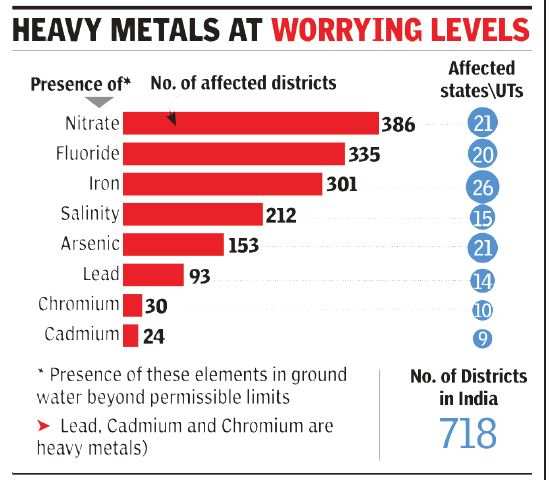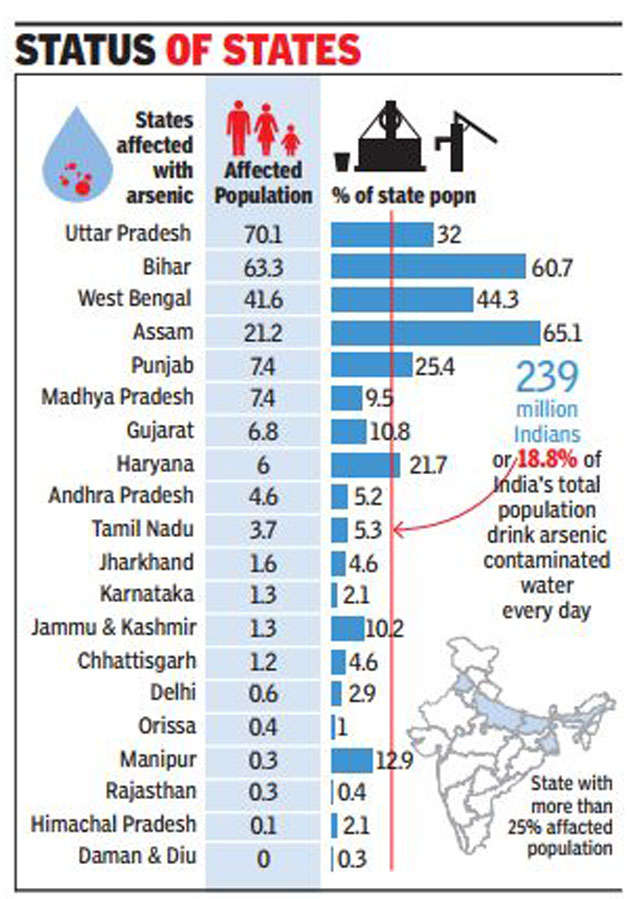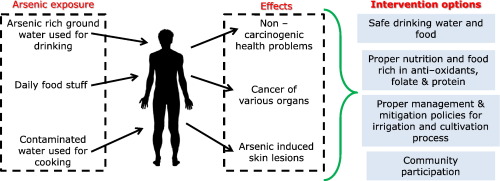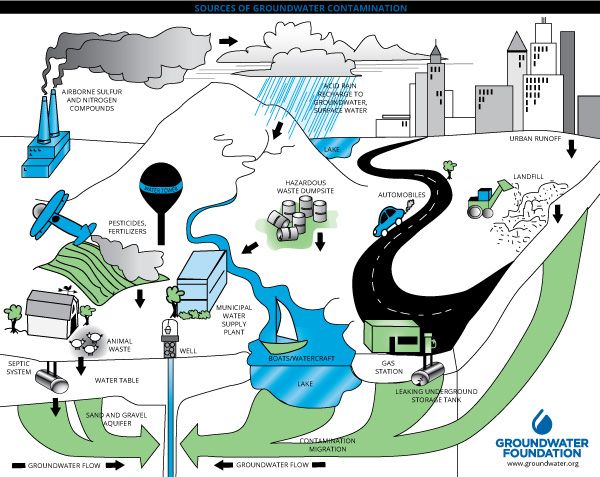The crucial role groundwater plays as a decentralized source of drinking water for millions rural and urban families cannot be overstated. According to some estimates, it accounts for nearly 80 per cent of the rural domestic water needs, and 50 per cent of the urban water needs in India. Groundwater is generally less susceptible to contamination and pollution when compared to surface water bodies.
Also, the natural impurities in rainwater, which replenishes groundwater systems, get removed while infiltrating through soil strata. But, In India, where groundwater is used intensively for irrigation and industrial purposes, a variety of land and water-based human activities are causing pollution of this precious resource. Its over-exploitation is causing aquifer contamination in certain instances, while in certain others its unscientific development with insufficient knowledge of groundwater flow dynamic and geo-hydrochemical processes has led to its mineralization.
Extent and Impacts of Groundwater Contamination and Pollution
The incidence of fluoride above permissible levels of 1.5ppm occur in 14 Indian states, namely, Andhra Pradesh, Bihar, Gujarat, Haryana, Karnataka, Kerala, Madhya Pradesh, Maharashtra, Orissa, Punjab, Rajasthan, Tamil Nadu, Uttar Pradesh and West Bengal affecting a total of 69 districts, according to some estimates. Some other estimates find that 65 per cent of India’s villages are exposed to fluoride risk.
High levels of salinity are reported from all these states except West Bengal and also the NCT of Delhi, and affects 73 districts and three blocks of Delhi. Iron content above permissible level of 0.3 ppm is found in 23 districts from 4 states, namely, Bihar, Rajasthan, Tripura and West Bengal and coastal Orissa and parts of Agartala valley in Tripura.
High levels of arsenic above the permissible levels of 50 parts per billion (ppb) are found in the alluvial plains of Ganges covering six districts of West Bengal. Presence of heavy metals in groundwater is found in 40 districts from 13 states, viz., Andhra Pradesh, Assam, Bihar, Haryana, Himachal Pradesh, Karnataka, Madhya Pradesh, Orissa, Punjab, Rajasthan, Tamil Nadu, Uttar Pradesh, West Bengal, and five blocks of Delhi.
Non-point pollution caused by fertilizers and pesticides used in agriculture, often dispersed over large areas, is a great threat to fresh groundwater ecosystems. Intensive use of chemical fertilizers in farms and indiscriminate disposal of human and animal waste on land result in leaching of the residual nitrate causing high nitrate concentrations in groundwater. Nitrate concentration is above the permissible level of 45 ppm in 11 states, covering 95 districts and two blocks of Delhi. DDT, BHC, carbamate, Endosulfan, etc. are the most common pesticides used in India. But, the vulnerability of groundwater to pesticide and fertilizer pollution is governed by soil texture, pattern of fertilizer and pesticide use, their degradation products, and total organic matter in the soil.
Pollution of groundwater due to industrial effluents and municipal waste in water bodies is another major concern in many cities and industrial clusters in India. A 1995 survey undertaken by Central Pollution Control Board identified 22 sites in 16 states of India as critical for groundwater pollution, the primary cause being industrial effluents. A recent survey undertaken by Centre for Science and Environment from eight places in Gujarat, Andhra Pradesh and Haryana reported traces of heavy metals such as lead, cadmium, zinc and mercury. Shallow aquifer in Ludhiana city, the only source of its drinking water, is polluted by a stream which receives effluents from 1300 industries. Excessive withdrawal of groundwater from coastal aquifers has led to induced pollution in the form of seawater intrusion in Kachchh and Saurashtra in Gujarat, Chennai in Tamil Nadu and Calicut in Kerala.

There are no estimates of the public health consequences of groundwater pollution as it involves methodological complexities and logistical problems. Nevertheless, levels of toxicity depend on the type of pollutant. Mercury is reported to cause impairment of brain functions, neurological disorders, retardation of growth in children, abortion and disruption of the endocrine system, whereas pesticides are toxic or carcinogenic. Generally, pesticides damage the liver and nervous system. Tumour formation in liver has also been reported.
The presence of fluoride in water cannot be detected without the help of water quality testing equipment. High fluoride content is often detected from such symptoms on human beings as yellowing of teeth, damaged joints and bone deformities, which occur from long years of exposure to fluoride containing water. Due to this reason, by the time the community realises the “menace”, a large section of the population is already affected. A recent survey by the International Water Management Institute (IWMI) in north Gujarat showed 42 per cent of the people covered in the sample survey (28,425) were affected; while 25.7 per cent were affected by dental fluorosis, 6.2 per cent were affected by muscular skeletal fluorosis and 10 per cent by both.
The potential biological and toxicological effects of using fluoride contaminated water are also dangerous. Study on fluorotic populations of north Gujarat revealed an increase in frequency of sister chromatic exchange in fluorotic individuals indicating that fluoride might have genotoxic effect. Fluoride had been reported to cause depressions in DNA and RNA synthesis in cultured cells. Another study on the effects of fluorides in mice showed significant reductions in DNA and RNA levels. Conditions including ageing, cancer, and arteriosclerosis are associated with DNA damage and its disrepair. Prolonged exposure to water containing salts (TDS above 500ppm) can cause kidney stone, a phenomenon widely reported from north and coastal Gujarat
Arsenic contamination of drinking water causes a disease called arsenicosis, for which there is no effective treatment, though consumption of arsenic free water could help affected people at early stages of ailment to get rid of the symptoms of arsenic toxicity. Arsenic contamination is by far the biggest mass poisoning case in the world putting 20 million people from West Bengal and Bangladesh at risk though some other estimates put the figure at 36 million people.

Issues in Tackling Groundwater Contamination and Pollution :
The first step towards evolving measures to prevent and cure groundwater quality deterioration is generating reliable and accurate information through water quality monitoring (WQM) to understand the actual source/cause, type and level of contamination. However, there are a few observation stations in the country that cover all the essential parameters for water quality and hence the data obtained are not decisive on the water quality status. Secondly, WQM involve expensive and sophisticated equipments that are difficult to operate and maintain and require substantial expertise in collecting, analyzing and managing data. Since water technology is still not advanced in India, it is very likely that the available data is less reliable. The existing methodology for WQM is inadequate to identify the various sources of pollution. Integration of data on water quality with data on water supplies, which is very important from the point of view of assessing water availability for meeting various social, economic and environmental objectives, is hardly done. And finally, in the absence of any stringent norms on water quality testing, results can change across agencies depending on sampling procedure, time of testing, and testing instruments and procedure.
Now let us examine technical issues in mitigating contamination. For seawater intrusion, artificial recharge techniques are available in India for different geo-hydrological settings. Artificial recharge could push seawater-freshwater interface seawards. These techniques can also be used to reduce the levels of fluoride, arsenic or salinity in aquifer waters on the principle of dilution. But, the issue is of availability of good water for recharging in arid and semi arid regions given the large aerial extent of contaminated aquifers. For industrial pollution, the issues are of three types: pumping out polluted water from the aquifer; treated this water to safe limits; and replenishing the depleted aquifer with freshwater. Technically feasible methods to clean polluted water often dot exist due to highly toxic substances in trade effluents as seen in a case in Rajasthan where a sulfuric acid manufacturing unit rendered drinking water source in 22 villages useless. Finding enough freshwater for replenishment was also a problem there.
In Indian context, it is not economically viable to clean aquifers. In the case of arsenic, methods for in situ treatment have already been in use in developed countries. In the United States, zerovalent, iron permeable reactive barriers (PRBs) are used in situ to remove chromium and several chlorinated solvents in groundwater and are tested successful for removing arsenic. India is too poor to afford some of the technologies that are successfully tried out in the West, especially United States because they are prohibitively expensive. The cost of cleaning the aquifer in the Rajasthan case was estimated to be Rs. 40 crores.
In India, groundwater quality monitoring is primarily the concern of the Central Ground Water Board and state groundwater agencies, where each of them set up their monitoring network. But there are issues concerning adequacy of scientific data available from them:
- The network of monitoring stations is not dense enough.
- Water quality analysis excludes critical parameters that help detect pollution by fertilizer and pesticide, heavy metals and other toxic effluents.
- The available scientific data, particularly that on pollution is of civil society institutions, and there is a paucity of such institutions that are capable of carrying out such professionally challenging, technologically sophisticated, and often politically sensitive tasks.
The Central Pollution Control Board (CPCB) and the State Pollution Control Boards (SPCBs) are the pollution watchdogs in India. Though monitoring of groundwater quality has come under their purview only recently and water quality of rivers is being monitored. But monitoring does not cover “non-point” pollution from agriculture. An analysis of the performance of the Gujarat State Pollution Control Board (GPCB) in Sabarmati river basin showed that of the four priority areas identified by the Board for operations, its performance has been satisfactory in only identification of areas facing severe pollution. The monitoring ability itself was doubtful as the agency maintains only two observation wells for groundwater quality monitoring in the entire basin. The GPCB also lacks adequate staff to carry out its functions
There are problems associated with institutional design itself. The SPCBs perform the dual functions of monitoring pollution and enforcing pollution control norms. But, the fact that regular WQM and its proper dissemination itself could question the existence of the Boards as an enforcement agency creates a disincentive for them to perform the first function meaningfully. Also, the agency lacks legal teeth and administrative apparatus to penalize polluters. This reduces the effectiveness of the agency in enforcing pollution control norms. The fact that cost of pollution is much less than the cost of treatment works as a disincentive for polluters, whereas the Boards are not mandated to execute environmental management projects.
Groundwater contamination most often occurs due to geo-hydro chemical processes activated by pumping. Once contamination starts, very little can be done to check it except a total ban on pumping. But this is very difficult, as millions of rural families in India depend on groundwater for sustaining irrigated agriculture and livelihoods. Any legal/regulatory interventions to ban pumping would mean depriving communities of their traditional rights. Though de jure rights in groundwater are not clear, land owners enjoy de facto right to extract groundwater under their land. While nitrate pollution can be properly controlled through following recommended dosage of fertilizers, crop rotation, proper timing of fertilizer application, and use of organic manure instead of chemical fertilizers, there are no institutional regimes governing fertilizer use and dumping of animal waste.
Reducing Impacts on Human Health
Reverse Osmosis (RO) is a process to get rid of all the impurities in drinking water including deadly ions and organisms and pesticide/fertilizer residues. Under RO-systems, water is made to pass through a membrane having a pore size of 0.0001micron under high pressure. Only 5-10 per cent of the ions are able to slip across the membrane, which is well within acceptable levels as per all standards including WHO, BIS, etc. RO systems are suitable for removing several of the toxic substances present in water in dissolved form, including fluoride, fertilizer and pesticide residues, and heavy metals. But costs vary, depending on the plant capacity and level of utilization, the level of salinity and other impurities in the water and the distance from the source of water. Costs can range between Rs.0.03/litre (for brackish water) to Rs.0.10/litre (for seawater).

A household arsenic treatment method is the ferric chloride coagulation system. This involves precipitation of arsenic by adding a packet of coagulant in 25 litres of tube well water, and subsequent filtration of the water through a sand filter. Field experiments showed arsenic concentration in treated water was nearly 1/20th that of raw water. The cost of chemical (ferric chloride) for treatment is Rs.0.09 per litre of raw water to be treated.
Another method for removing arsenic is based on “sorptive filtration based on iron coated sand bed”. Water is first put in a bucket and stirred for some time to accelerate precipitation of excess iron. It is then allowed to pass through a sand filter where the excess iron is filtered out. Finally the water is passed through an iron coated sand filter. But, the efficiency of removing arsenic reduces drastically beyond a certain bed volume with the arsenic concentration of treated water crossing the permissible limit of 50 ppb. The third method involves filtration of arsenic from raw water by passing it through a gravel media containing iron sludge. An evaluative study showed the first two systems to be superior, with the first one found to be most acceptable to the villagers.
Emerging Challenges
The available treatment systems work on the principles in physics and chemistry. Hence, their efficiency depends heavily on maintaining certain specified operating conditions. This would call upon qualified technical manpower for system operations, and regular operation and maintenance, which are mostly absent. The Gujarat Water Supply and Sewerage Board set up 28 desalination systems since 1989. All of them became dysfunctional within a very short span of time. Most of the 117 desalination plants commissioned in eight states by government agencies became non-operational due to lack of technical manpower for maintenance and improper selection of membrane.
Most of the treatment systems for drinking water have to be tried out at the community level to be cost effective and affordable. With no major revenues being accrued by government agencies from domestic water supply services, any additional investment for provision of safe water for drinking and cooking purposes would induce unprecedented financial burden. Therefore, it will be more appropriate to build and operate water treatment systems on the principle of full cost recovery. The water supplied from the system has to be affordable to all classes of the society as drinking is essential for survival. Therefore, unit cost of production should be minimized for commercial viability
The unit cost of production could be brought down considerably by running the plant at peak capacity, which means creating sufficient demand. Higher demand means lower selling price of water for commercial viability. Whereas increase in plant capacity can reduce unit cost, this lowers the chances of running the plant at full capacity, which means higher operating costs. Hence, optimal plant design, proper selection of membrane, generating sufficient demand etc. are important for bringing down the cost of production. The level of professional inputs that go into management of public water supply systems would be far less than adequate to manage these systems. Over and above, operating costs for agency-run systems are likely to be high due to high administrative overheads. As a result, new techno institutional models need to be evolved to manage the system in order to make them self sustaining. Involving private sector in provision of clean and safe drinking water would be a major step towards achieving this.

It is ordinary people who raise the alarm about poor water quality. Civil society/institutions need to be strengthened to respond to water quality problems quickly. This is possible through better knowledge and information about the nature of groundwater contamination, potential sources of threats to groundwater quality in their region and degrees of vulnerability, the ill-effects of using contaminated water, and the possible preventive measures.
They can in turn put pressure on the line agencies to perform. Strengthening civil society institutions is particularly important because groundwater quality variations in nature are often sporadic; it is extremely difficult for monitoring agencies to establish an elaborate network of WQM stations due to the high costs and technical manpower involved. Given the absence of complete information about quality of water in various sources, it is also not possible for line agencies to identify appropriate treatment measures. Also, the willingness of people to pay for water is directly linked to their knowledge and awareness about ill-effects of drinking contaminated/polluted water. Credible and technically competent NGOs can play a big role in strengthening civil society, by generating the vital database on groundwater quality.
Conclusions and Policy Inferences
Preventive and curative measures against pollution and contamination of groundwater may continue to receive low priority for years to come, and technological measures to prevent the ill effects on human health will get priority in short term. Demineralization using RO system can remove all hazardous impurities from drinking water and would be cost effective in many situations where TDS, nitrate and fluoride in groundwater are above permissible levels. The cost of demineralization is falling rapidly. Saudi Arabia meets 20 per cent of its total water needs from desalinated sea water, and Saudi technologists believe desalination costs would fall so rapidly over the coming decades that desalination will be cheaper than pumping coastal aquifers. Low cost treatment methods are available for removal of arsenic from groundwater.
There are, however, challenges that water utilities would face such as building technical and managerial skills to design, install, operate and manage water treatment systems, making people pay for treated water and building knowledge and awareness among communities about groundwater quality issues and treatment measures. For the long run, policies need to be focused on building scientific capabilities of line agencies concerned with WQM, water supplies, and pollution control; and restructuring them to perform WQM and enforcement of pollution control norms effectively and to enable them implement environmental management projects.
Saving water is in every season but,
Let’s harvest rainwater this rainy season.
Vardhman Envirotech,
India’s Passionate Rainwater Company

